
Crazy Climber is a vertically scrolling video game produced by Nichibutsu and released for arcades in 1980. In North America, the game was also released by Taito America. Ports for the Arcadia 2001 and Atari 2600 were published in 1982, followed by the Famicom in 1986 and X68000 in 1993.

Ikari Warriors, known as Ikari in Japan, is a vertically scrolling run and gun video game released for arcades by SNK in 1986. It was published in North America by Tradewest. At the time there were many Commando clones on the market. What distinguished Ikari Warriors were rotary joysticks and a two-player cooperative mode. The rotary joystick controls were in turn based on SNK's earlier TNK III (1985). Ikari was originally intended to be an official licensed adaptation of the film Rambo: First Blood Part II (1985), but SNK were initially unable to acquire the rights to the film.
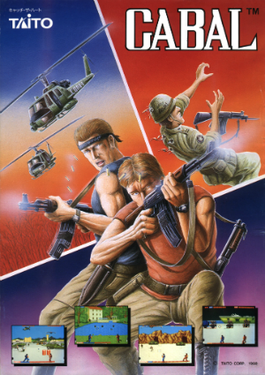
Cabal is a 1988 arcade shooter video game originally developed by TAD Corporation and published in Japan by Taito, in North America by Fabtek and in Europe by Capcom. In the game, the player controls a commando, viewed from behind, trying to destroy various enemy military bases. The game was innovative for the era, but only a mild success in the arcades, and became better known for its various home conversions.
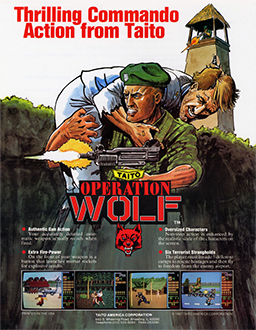
Operation Wolf is a light gun shooter arcade game developed by Taito and released in 1987. It was ported to many home systems.

Commando, released as Senjō no Ōkami in Japan, is a vertically scrolling run and gun video game released by Capcom for arcades in 1985. The game was designed by Tokuro Fujiwara. It was distributed in North America by Data East, and in Europe by several companies including Capcom, Deith Leisure and Sega, S.A. SONIC. Versions were released for various home computers and video game consoles. It is unrelated to the 1985 film of the same name, which was released six months after the game.
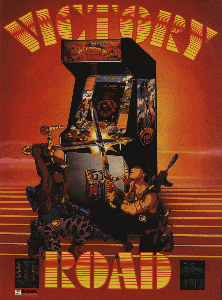
Victory Road, also known as Dogō Sōken in Japan and Ikari Warriors II: Victory Road in North America, is a run and gun video game released by SNK for arcades in 1986. The game is a sequel to Ikari Warriors, released earlier the same year.

Ikari III: The Rescue, simply known as Ikari III (怒III) in Japan, is a 1989 arcade run & gun shoot 'em up beat 'em up game developed and published by SNK. It was ported to the NES, IBM PC compatibles, and Commodore 64. It is the third and final installment of the Ikari Warriors series after Ikari Warriors and Victory Road. The NES version was shown at the 1991 CES.

Guerrilla War, released in Japan as Guevara (ゲバラ), is an overhead run and gun video game developed and published by SNK. Originally released in 1987 as a coin-operated arcade game, Guerrilla War was ported to the Amstrad CPC, Apple II, Commodore 64, MS-DOS, Nintendo Entertainment System, PlayStation Network, and ZX Spectrum.
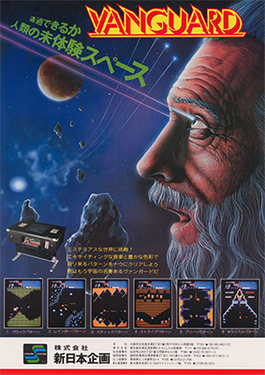
Vanguard is a scrolling shooter arcade video game developed by TOSE. It was released by SNK in Japan and Europe 1981, and licensed to Centuri for manufacture in North America in October and to Zaccaria in Italy the same year. Cinematronics converted the game to cocktail arcade cabinets in North America.

Gun.Smoke is a vertically scrolling run and gun video game and designed by Yoshiki Okamoto and released in arcades in 1985. Gun.Smoke centers on a character named Billie Bob, a bounty hunter going after the criminals of the Wild West.

Grobda is a 1984 multidirectional shooter arcade video game developed and published by Namco. It is a spin-off from Xevious, as the player's tank first appeared in that game as an enemy. It runs on Namco Super Pac-Man hardware but with a video system like that used in Mappy and The Tower of Druaga, and it also uses a DAC for the "Get Ready" speech sample at the start of each round.
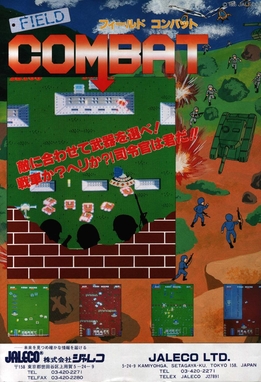
Field Combat is a 1985 shooter video game developed and published by Jaleco for arcades. In Field Combat, the player fights as a commanding officer in a futuristic battlefield. It was ported to the Famicom by Tose, which was later re-released for the Wii's Virtual Console in 2007. A sequel game, Field Combat DX, was released for Japanese mobile phones in 2004.
Ozma Wars is a fixed shooter arcade video game developed by Shin Nihon Kikaku (SNK) and released in 1979. The moving starfield background gives the impression of vertical scrolling, but the player ship's movement is restricted to the bottom of the screen.
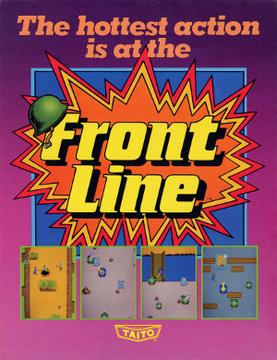
Front Line is a military-themed run and gun video game released by Taito for arcades in November 1982. It was one of the first overhead run and gun games, a precursor to many similarly-themed games of the mid-to-late 1980s. Front Line is controlled with a joystick, a single button, and a rotary dial that can be pushed in like a button. The single button is used to throw grenades and to enter and exit tanks, while the rotary dial aims and fires the player's gun.

Boot Hill is a multidirectional shooter arcade video game released by Midway in 1977. It is a sequel to the 1975 video game Gun Fight, originally released by Taito as Western Gun in Japan. It was released under license from Taito, as Boot Hill is another version of Western Gun.
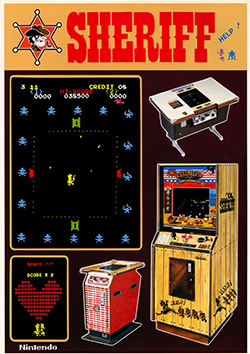
Sheriff, also known as Bandido, is a 1979 multi-directional shooter arcade game by Nintendo. It is one of several Western-themed video games from the 1970s, along with Western Gun, Outlaw, and Boot Hill. The player controls a county sheriff tasked with defense of a town against bandits, to rescue the captured woman. It was a commercial success in Japan, where it was among the top ten highest-grossing arcade games of 1979.

Exerion is a fixed shooter video game developed and published by Jaleco for arcades in September 1983, and licensed to Taito for manufacture and distribution of the game in North America. The player controls a starship and must fire at enemies on the screen while avoiding projectiles. The game uses a pseudo-3D scrolling background, giving a sense of depth, and the player's ship has a sense of inertia while it is being controlled with the joystick.
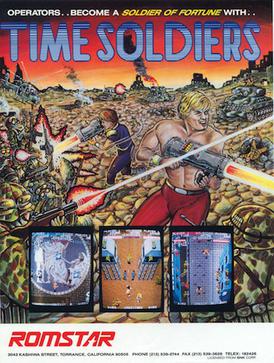
Time Soldiers, known in Japan as Battle Field, is a 1987 run and gun video game developed by Alpha Denshi for arcades and published by SNK. It was distributed in North America by Romstar. A Master System version was also produced, as well as versions titled Time Soldier for the Amiga, Commodore 64, and Atari ST.
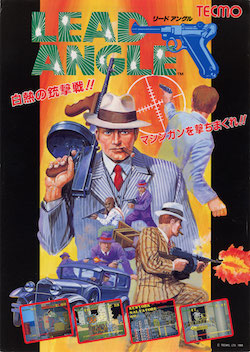
Dead Angle, also known as Lead Angle and Gang Hunter, is a 1988 arcade shooter game developed by Seibu Kaihatsu. It is the follow-up to the company's mobster-themed Empire City: 1931. In Dead Angle, players take control of the game's protagonist, who must rescue his girlfriend from a mob boss. A port of the game was released by Sega for the Master System console.
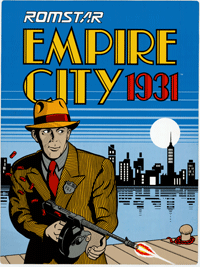
Empire City: 1931 is a shooter game developed by Seibu Kaihatsu that was originally released into arcades in 1986, by Taito in Japan and Europe and by Romstar in North America. The game has players taking on the mafia in 1931 New York City by gunning down mobsters one by one.



















